Class 9 Science Chapter 8 Motion NCERT Solutions
Page 100
1. An object has moved through a distance. Can it have zero displacement? If yes, support your answer with an example.
Answer:
Displacement is the shortest distance between initial and final position of body along with direction.Yes, an object moved through a distance can have zero displacement. For Ex: Suppose a body is moving in a circular path and start moving from point and returns back at the same point after completing one revolution, then the distance will be equal to its circumference while displacement will be zero.
2. A farmer moves along the boundary of a square field of side 10 m in 40 s. What will be the magnitude of displacement of the farmer at the end of 2 minutes 20 seconds from his initial position?
Answer:
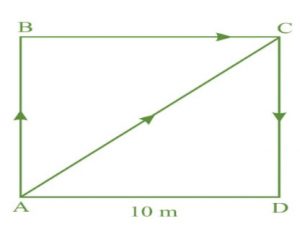
Side of the square field= 10 m
Perimeter = 10 × 4 = 40 m
Farmer moves along the boundary in 40 s
Time = 2 min 20 sec = 140 sec
Since in 40 s farmer moves 40 m
Therefore , in 1 s distance covered by farmer = 40 ÷ 40 = 1 m
Therefore , in 140 s distance covered by farmer = 1 × 140 = 140 m
Number of rotation to cover 140 along the boundary = Total distance / perimeter
= 140/ 40 = 3.5 m
After 3.5 round farmer will be at point C of the field.
Therefore , displacement = [(10)2 + (10)2 ]½
=14.1 m
After 2 min 20 sec the displacement of the farmer will be 14.1 m north east from initial position.
3. Which of the following is true for displacement? (a) It cannot be zero. (b) Its magnitude is greater than the distance travelled by the object.
a) Displacement can become zero when the initial and final position of the object is the same.
b) Displacement cannot be greater than magnitude of the distance travelled by the object.
Page 102
1. Distinguish between speed and velocity.
Answer:
| Speed | Velocity |
| It is the distance travelled by a body per unit time. | It is the distance travelled by a body per unit time in a given direction. |
| It is a scalar quantity. | It is a vector quantity. |
| It has only magnitude. | It has both magnitude and direction. |
2. Under what condition(s) is the magnitude of average velocity of an object equal to its average speed?
Answer:
The magnitude of average velocity of an object equal to its average speed , only when an object is moving in a straight line.
3. What does the odometer of an automobile measure?
Answer:
The odometer of an automobile measures the distance covered by an automobile.
4. What does the path of an object look like when it is in uniform motion?
Answer:
In the case of uniform motion, the path of an object will look like a straight line.
5. During an experiment, a signal from a spaceship reached the ground station in five minutes. What was the distance of the spaceship from the ground station? The signal travels at the speed of light, that is, 3 × 108 m s–1 .
Answer:
Speed = 3×108 m/s
Time = 5 minute = 5 × 60 s = 300 s
Using, Distance = Speed × Time
⇒ Distance = 3 ×108 × 300 m = 900 × 108 m= 9.0 × 1010 m
Page 103
1. When will you say a body is in (i) uniform acceleration? (ii) non-uniform acceleration?
Uniform acceleration
Answer:
A body has a uniform acceleration if it travels in a straight line and its velocity increases by equal amount in equal intervals of time.
For Example : Motion of freely falling body, bicycle going down the slope, ball rolling down in inclined plane.
Non-uniform acceleration
Answer: A body has a non-uniform acceleration if its velocity increases by unequal amount in equal intervals of time. For Example : Car running on a crowded city road(At one moment its velocity increases and at other velocity decreases.
2. A bus decreases its speed from 80 km h–1 to 60 km h–1 in 5 s. Find the acceleration of the bus.
Answer:
u = 80 km/h =(80×1000)/3600ms−1
=200/9 ms−1
= 22.22 ms−1
v = 60 km/h =(60×1000)/3600ms−1
=150/9ms−1
= 16.67 ms−1
t = 5 s
Therefore, acceleration, a = ?
We know that, v = u + at
a= (v-u)/t
a= (16.66-22.22)/5
a= -1.1 m/s2
Therefore, Acceleration is -1.1 ms-2
3. A train starting from a railway station and moving with uniform acceleration attains a speed 40 km h–1 in 10 minutes. Find its acceleration.
Answer:
Initial velocity of train, u=0
Final velocity of train = 40Km/hr = 40 ×(5/18) = 100/9 ms-1
=11.11 ms-1
Time taken = 10 min= 10 ×60=600 sec
Acceleration= (u-v)/t
Acceleration= (0-11.11)/600
Acceleration=0.0185 ms-2
Page 107
1. What is the nature of the distance-time graphs for uniform and non-uniform motion of an object?
Answer:
Distance-time graph for uniform motion
Distance-time graph for non-uniform motion
2. What can you say about the motion of an object whose distance-time graph is a straight line parallel to the time axis?
Answer:
If the distance time graph is a straight line parallel to the time axis then the body is at rest.
3. What can you say about the motion of an object if its speed time graph is a straight line parallel to the time axis?
Answer:
When the speed time graph is a straight line parallel to time axis then the motion of an object is constant or uniform motion.
4. What is the quantity which is measured by the area occupied below the velocity-time graph?
Answer:
The quantity of distance is measured by the area occupied below the velocity time graph.
Page 109, 110
1. A bus starting from rest moves with a uniform acceleration of 0.1 m s-2 for 2 minutes. Find (a) the speed acquired, (b) the Q distance travelled.
Answer:
a) Initial velocity=0 m/s
Acceleration = 0.1 m/s2
Time= 2 min= 120 sec
Speed acquired= v=u+at
v=0+ 0.1×120
v=12 m/s
b) According to the third equation of motion
v2 =u2-2aS
(12)2 = (o)2 – 2 × 0.1 × S
S= 720 m
Distance travelled by bus is 720 m.
2. A train is travelling at a speed of 90 km h–1 . Brakes are applied so as to produce a uniform acceleration of – 0.5 m s-2. Find how far the train will go before it is brought to rest.
Answer:
Initial velocity, u = 90 km/hr =( 90 × 1000)/ 3600 m/s =25 m/s
Final velocity , v =0 m/s
Acceleration= -0.5 m/s2
Using, v2 = u2 -2aS
(0)2 = (25)2 -2 × (-0.5) × S
S= 625 m
3. A trolley, while going down an inclined plane, has an acceleration of 2 cm s-2. What will be its velocity 3 s after the start?
Answer:
Initial velocity of trolley , u = 0 m/s
Acceleration= 2 cm s-2 = 0.02 m s-2
Time= 3 sec
v=u +at
v= 0+ 0.02 × 3
v= 0.06 m/s
Velocity of trolley after 3 s from start is 0.06 m/s
4. A racing car has a uniform acceleration of 4 m s-2. What distance will it cover in 10 s after start?
Answer:
Acceleration , a= 4 m s-2
Initial velocity , u= 0 m/s
Time, t= 10 s
S= ut+ ½ at2
S = 0× 10 + ½ × 4× (10)2
S= 200 m
Racing car will cover a distance of 200 m after start in 10 s with given acceleration.
5. A stone is thrown in a vertically upward direction with a velocity of 5 m s-1. If the acceleration of the stone during its motion is 10 m s–2 in the downward direction, what will be the height attained by the stone and how much time will it take to reach there?
Answer:
Initial velocity , u= 5 m/s
Final velocity ,v = 0 m/s
Acceleration = -10 m/s2
v2 =u2-2aS
(0)2 = (5)2 -2×(-10) × S
S=1.25 m
Stone will attain a height of 1.25 m
v=u +at
0 =5 + (-10)×t
0= 5-10t
10t=5
t= o.5 s
Time taken to attain the height is o.5 sec.
Page 112, 113
1. An athlete completes one round of a circular track of diameter 200 m in 40 s. What will be the distance covered and the displacement at the end of 2 minutes 20 s?
Answer:
Time taken = 2 min 20 sec =140 sec
Diameter of circular track=200 m
Radius of circular track = 100 m
Time taken by athlete for one round= 40sec
In 140 sec the athlete will complete= 140/ 40 = 3.5 round
Distance covered by athlete in 140 sec =2πr = 2 × 3.14 × 3.5 ×100 =2200 m
Displacement of the athlete= Diameter of circular track =200 m
2. Joseph jogs from one end A to the other end B of a straight 300 m road in 2 minutes 30 seconds and then turns around and jogs 100 m back to point C in another 1 minute. What are Joseph’s average speeds and velocities in jogging (a) from A to B and (b) from A to C?
a) For motion A to B
Answer:
Distance covered = 300 m
Displacement= 300 m
Time taken= 150 m
Average speed = Total distance covered/ total time taken
Average speed = 300/150= 2 m/s
Average velocity = Net displacement / time taken
Average velocity = 300/150= 2 m/s
b) For motion A to C
Distance covered= 300 +100 = 400 m
Displacement= 300-100 =200 m
Time taken = 2.5 + 1 = 3.5 min = 210 sec
Average speed = Total distance covered/ total time taken
Average speed = 400/210 = 1.90 m/s
Average velocity = Net displacement / time taken
Average velocity = 200/210 =0.952 m/s
3. Abdul, while driving to school, computes the average speed for his trip to be 20 kmh–1. On his return trip along the same route, there is less traffic and the average speed is 30 kmh–1. What is the average speed for Abdul’s trip?
Answer:
Abdul average speed = 20 Kmh-1
Average speed = Total distance/ Total time taken
Let the distance be x km.
Time taken for forward trip at a speed of 20 km/hr = x/20
Time taken for forward trip at a speed of 30 km/hr = x/30
Total time taken for whole trip = x/20+ x/30 = 5x/60 h
Total distance covered= 2x km
Average speed= Total distance/ time taken
Average speed = 2x ÷ (5x/60)
Average speed = 24 km/hr
4. A motorboat starting from rest on a lake accelerates in a straight line at a constant rate of 3.0 m s–2 for 8.0 s. How far does the boat travel during this time?
Answer:
u= 0 m/s
a= 3 m/s2
t= 8 sec
S = ut + ½ at2
S = 0 × 8 + ½ × 2 × (8)2
S = 96 m
5. A driver of a car travelling at 52 kmh–1 applies the brakes and accelerates uniformly in the opposite direction. The car stops in 5 s. Another driver going at 3 kmh–1 in another car applies his brakes slowly and stops in 10 s. On the same graph paper, plot the speed versus time graphs for the two cars. Which of the two cars travelled farther after the brakes were applied?
Answer:
Distance travelled by first car before coming to rest = area of ΔPOR
= ½ × OR ×OP
= ½ × 5s × 52 kmh-1
=½ × 5 × (52 × 1000)/36) ms-1
= 36.11 m
Distance travelled by second car before coming to rest = area of ΔSOQ
= ½ × OQ ×OS
= ½ × 10s × 3 kmh-1
=½ × 10 × (3 × 1000)/36) ms-1
= 47.2 m
Second car travel farther than the first car after they applied the brake.
6. Fig 8.11 shows the distance-time graph of three objects A,B and C. Study the graph and answer the following questions: Fig. 8.11
(a) Which of the three is travelling the fastest?
(b) Are all three ever at the same point on the road?
(c) How far has C travelled when B passes A?
(d) How far has B travelled by the time it passes C?
Answer:
a) Object B
b) All the three are never at same point on the road.
c) 7 small boxes= 4 km
1 small box= 4/7 km
C is 4 blocks away from origin therefore initial distance of C from origin= 16/7
Distance of C from B when B passes A = 8 km
Distance travelled by C when B passes A = 8-(16/7)
= (56-16)/7 = 5.71 km
d) Distance travelled by B by the time it passes C = 9 square boxes
(4/7) × 9 = 5.14 km
7. A ball is gently dropped from a height of 20 m. If its velocity increases uniformly at the rate of 10 m s-2, with what velocity will it strike the ground? After what time will it strike the ground?
Answer:
u= 0 m/s
s = 20 m
a = 10 m/s2
v2= u2-2aS
v2 -0 = 2 × 10 × 40
v= 20 m/s
t= (v-u)/t
t= 20/10 = 2 sec
8. The speed-time graph for a car is shown is Fig. 8.12. Fig. 8.12 (a) Find how far does the car travel in the first 4 seconds. Shade the area on the graph that represents the distance travelled by the car during the period. (b) Which part of the graph represents uniform motion of the car?
Answer:
a) Distance covered = area under speed-time
= ½ × 4 × 6 = 12 m
b) The part of a graph in brown colour represents uniform motion of the car.
9. State which of the following situations are possible and give an example for each of these: (a) an object with a constant acceleration but with zero velocity
(b) an object moving with an acceleration but with uniform speed.
(c) an object moving in a certain direction with an acceleration in the perpendicular direction.
Answer:
a)Yes
When a ball is thrown up at a maximum height, it has zero velocity, although it will have constant acceleration due to gravity.
b) Yes
When a car is moving in circular track, its acceleration is perpendicular to its direction.
10. An artificial satellite is moving in a circular orbit of radius 42250 km. Calculate its speed if it takes 24 hours to revolve around the earth.
Answer:
r= 42250 km =4225000o m
T= 24 × 60 × 60
Speed = Distance/ time
Speed = 2πr /T
Speed = (2 × 3.14 × 4225000o) / 24 × 60 × 60
Speed = 3070.9 m/s
Speed = 3.07 Km/s
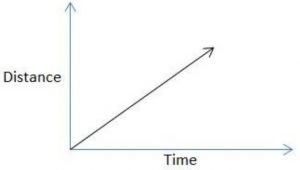
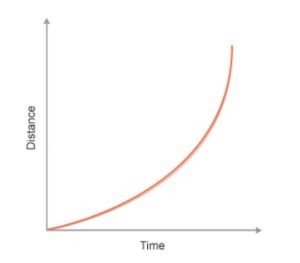
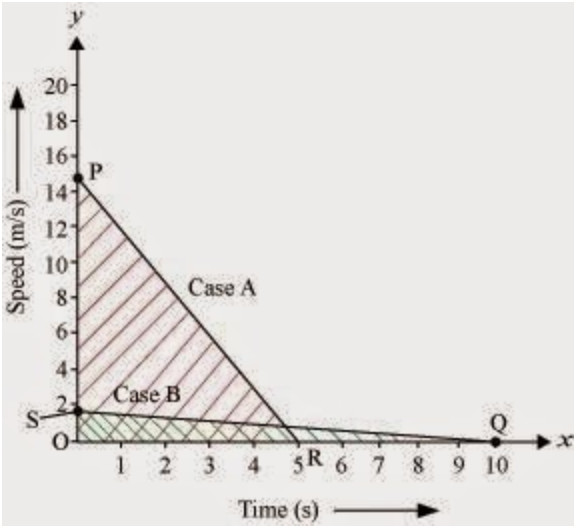
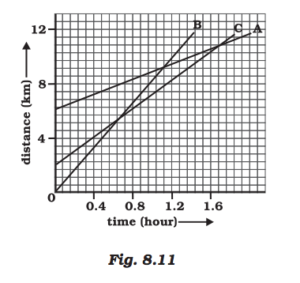
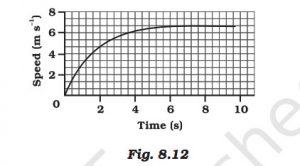
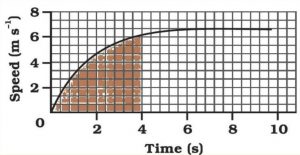
Thanks for providing this information wish u all the best
Good notes on chapter 8 motion class 9